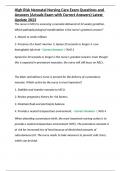High risk neonate - Study guides, Class notes & Summaries
Looking for the best study guides, study notes and summaries about High risk neonate? On this page you'll find 3307 study documents about High risk neonate.
Page 4 out of 3.307 results
Sort by
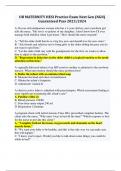
-
OB MATERNITY HESI Practice Exam Next Gen (NGN) Guaranteed Pass 2023/2024
- Exam (elaborations) • 27 pages • 2023
-
- $16.00
- 1x sold
- + learn more
A 30-year-old multiparous woman who has a 3-year-old boy and a newborn girl tells the nurse, "My son is so jealous of my daughter, I don't know how I'll ever manage both children when I get home." How should the nurse respond? A. "Tell the older child that he is a big boy now and should love his new sister." B. "Ask friends and relatives not to bring gifts to the older sibling because you do not want to spoil him." C. "Let the older child stay with his grandparents for the first si...
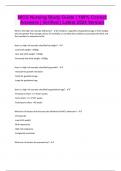
-
NICU Nursing Study Guide | 100% Correct Answers | Verified | Latest 2024 Version
- Exam (elaborations) • 13 pages • 2024
- Available in package deal
-
- $11.49
- + learn more
What is the high risk neonate defined as? - A newborn, regardless of gestational age or birth weight, who has greater than average chance of morbidity or mortality d/t conditions associated with birth and the transition to extrauterine life. How is a high risk neonate classified by weight? - -Low birth weight: <2500g -Very low birth weight: <1500g -Extremely low birth weight: <1000g How is a high risk neonate classified by growth? - -Intrauterine growth restriction -Small for...
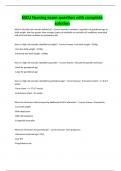
-
NICU Nursing exam question with complete solution
- Exam (elaborations) • 14 pages • 2024
-
- $12.99
- + learn more
NICU Nursing exam question with complete solution What is the high risk neonate defined as? - Correct Answer A newborn, regardless of gestational age or birth weight, who has greater than average chance of morbidity or mortality d/t conditions associated with birth and the transition to extrauterine life. How is a high risk neonate classified by weight? - Correct Answer -Low birth weight: <2500g -Very low birth weight: <1500g -Extremely low birth weight: <1000g How is a high ri...

-
NICU Nursing Exam Questions with Correct Answers
- Exam (elaborations) • 10 pages • 2024
-
Available in package deal
-
- $13.99
- + learn more
NICU Nursing Exam Questions with Correct Answers What is the high risk neonate defined as? - Answer-A newborn, regardless of gestational age or birth weight, who has greater than average chance of morbidity or mortality d/t conditions associated with birth and the transition to extrauterine life. How is a high risk neonate classified by weight? - Answer--Low birth weight: <2500g -Very low birth weight: <1500g -Extremely low birth weight: <1000g How is a high risk neonate clas...
High Risk Neonatal Nursing Care Exam Questions and Answers (Actuals Exam with Correct Answers) Latest Update 2023
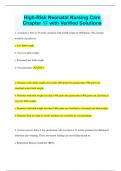
-
High-Risk Neonatal Nursing Care Chapter 17 with Verified Solutions
- Exam (elaborations) • 24 pages • 2024
-
Available in package deal
-
- $9.99
- + learn more
High-Risk Neonatal Nursing Care Chapter 17 with Verified Solutions 1. A neonate is born at 33 weeks' gestation with a birth weight of 2400 grams. This neonate would be classified as: a. Low birth weight b. Very low birth weight c. Extremely low birth weight d. Very premature ANS: a a. Neonates with a birth weight of less than 2500 grams but greater than 1500 grams are classified as low birth weight. b. Neonates with birth weight less than 1500 grams but greater than 1000 grams are...

-
Neonatal and Pediatric Respiratory Care 5th Edition Walsh Test Bank
- Exam (elaborations) • 239 pages • 2022
-
- $18.42
- 3x sold
- + learn more
TEST BANK FOR NEONATAL AND PEDIATRIC RESPIRATORY CARE 5TH EDITION BY WALSH Table of Contents Section 1: Fetal Development Assessment, and Delivery 1. Fetal Lung Development 2. Fetal Gas Exchange and Circulation 3. Antenatal Assessment and High-Risk Delivery Section 2: Assessment and Monitoring of the Neonatal and Pediatric Patient 4. Examination and Assessment of the Neonatal and Pediatric Patient 5. Pulmonary Function Testing and Bedside Pulmonary Mechanics 6. Radiographic Assessment 7. Ped...
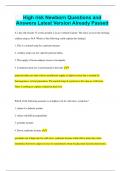
-
High risk Newborn Questions and Answers Latest Version Already Passed
- Exam (elaborations) • 13 pages • 2024
-
Available in package deal
-
- $9.99
- + learn more
High risk Newborn Questions and Answers Latest Version Already Passed A 1 day old neonate 32 weeks gestatin is in an overhead warmer. The nurse assesses the morning axillary temp as 96.9. Which of the following could explain this finding? 1. This is a normal temp for a preterm neonate 2. Axillary temps are not valid for preterm babies 3. The supply of brown adipose tissue is incomplete 4. Conduction heat loss is pronounced in the baby 3 (preterm babies are born with an insufficient sup...

-
High Risk Neonatal Nursing Care Questions and Answers 100% Pass
- Exam (elaborations) • 10 pages • 2024
-
Available in package deal
-
- $9.99
- + learn more
High Risk Neonatal Nursing Care Questions and Answers 100% Pass The nurse in NICU is assessing a neonate delivered at 32 weeks gestation. Which pathophysiological manifestation is the nurse's greatest concern? 1. Absent or weak reflexes 2. Presence of a heart murmur 3. Apnea 20 seconds or longer 4. Low hemoglobin lab level ANS 3 Apnea for 20 seconds or longer is the nurse's greatest concern. Even though this is expected in premature neonates, the nurse will still focus on ABCs. ...
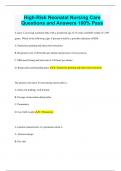
-
High-Risk Neonatal Nursing Care Questions and Answers 100% Pass
- Exam (elaborations) • 46 pages • 2024
-
Available in package deal
-
- $11.99
- + learn more
High-Risk Neonatal Nursing Care Questions and Answers 100% Pass A nurse is assessing a preterm baby with a gestational age of 32 weeks and birth weight of 1,389 grams. Which of the following signs if present would be a possible indication of RDS. A. Expiratory grunting and intercostal retractions. B. Respiratory rate of 46 breaths per minute and presence of acrocyanosis. C. Mild nasal flaring and heart rate of 140 beats per minute. D. Bradycardia and bounding pulse A. Expiratory gruntin...

$6.50 for your textbook summary multiplied by 100 fellow students... Do the math: that's a lot of money! Don't be a thief of your own wallet and start uploading yours now. Discover all about earning on Stuvia

